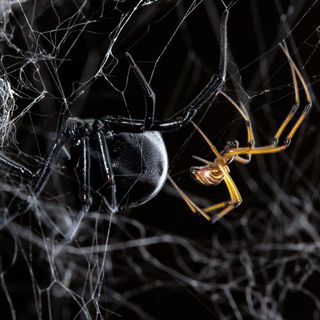Male Spiders Must Twerk — or Be Eaten

Miley Cyrus may have made "twerking" a household word, but male black widow spiders are the real masters of the rump-jiggling dance move. These arachnids twerk their abdomens to avoid getting eaten by potential mates.
The vibrations caused by the male spider's twerking travel along the females' webs, alerting the females to the presence of a potential mate, a new study finds. The vibrations are very different from the staccato, sporadic movements caused by ensnared prey.
"They take a few steps and then they stop and vibrate their abdomen, and then they take a few steps and vibrate again," study researcher Samantha Vibert, a doctoral candidate at Simon Fraser University in Canada, said of the males.
Vibert and her colleagues reported their findings today (Jan. 16) in the journal Frontiers in Zoology. [See Video of the Twerking Spiders]
Spiders use their webs as extensions of their own bodies, able to sense vibrations on the threads that trigger their response to prey. But when an arachnid gentleman caller comes along, he runs the risk of being mistaken for a delicious moth and attacked.
Vibert knew from observing hobo spiders (Tegenaria agrestisi) that mating spiders perform elaborate dances. She wanted to know what was behind these complex displays.
To find out, she and her colleagues investigated two web-dwelling spiders, the western black widow (Latrodectus Hesperus) and the hobo spider. Hobo spiders produce sheet webs, whose familiar, organized patterns usually come to mind when people think of spiderwebs. Black widows produce tangle webs, which look like cobwebs.
Sign up for the Live Science daily newsletter now
Get the world’s most fascinating discoveries delivered straight to your inbox.
First, the researchers recorded vibrations of male spiders venturing onto females' webs as well as the vibrations made when a house fly or house cricket got trapped by the sticky silk. The researchers then compared the vibrations' duration, frequency and amplitude.
They found that prey and potential mates make very different vibrations. The male spiders produced continuous, long-duration vibrations with low amplitudes, meaning that they were "quiet" compared to the sporadic, percussive vibrations made by trapped prey.
The differences were especially pronounced in black widow spiders, Vibert told LiveScience. Male black widows produced these good vibes by moving their abdomens in a rapid motion — reminiscent of twerking.
Good vibrations
Next, the researchers played recorded vibrations onto webs occupied by females. The scientists tested vibrations from both prey and male spiders, played on either high or low, and watched how the females responded.
"It didn't really matter what the vibration sounded like, but it had to be quiet," Vibert said. "If you play back a very quiet, whisperlike vibration, then the females did not respond aggressively."
Strong vibrations sent the female spiders scurrying over in attack mode. But little whispers simply got their attention — some turned toward the source of the vibrations, and some even responded with abdominal twitches of their own, suggesting back-and-forth communication.
That wouldn't be the only amazing trick spiders can play with their webs. On Jan. 8, a YouTube video revealed the magic of the slingshot spider (probably a species called Naatlo splendida), which actually flings its entire web at potential prey.
Still, it's the communication aspect that amazes Vibert.
"I think what really blew my mind was just how complex their signaling system is," she said. Courting spiders often show off with graceful dances, bobbing, weaving and circling around their intended mate, Vibert said.
"Spiders can be really beautiful, and they're a lot more complex than most people give them credit for," Vibert said. "If you go past the spider fear, the phobia, there are really quite a lot of things that will make you smile."
Follow Stephanie Pappas on Twitter and Google+. Follow us @livescience, Facebook & Google+. Original article on LiveScience.

Stephanie Pappas is a contributing writer for Live Science, covering topics ranging from geoscience to archaeology to the human brain and behavior. She was previously a senior writer for Live Science but is now a freelancer based in Denver, Colorado, and regularly contributes to Scientific American and The Monitor, the monthly magazine of the American Psychological Association. Stephanie received a bachelor's degree in psychology from the University of South Carolina and a graduate certificate in science communication from the University of California, Santa Cruz.
Most Popular

